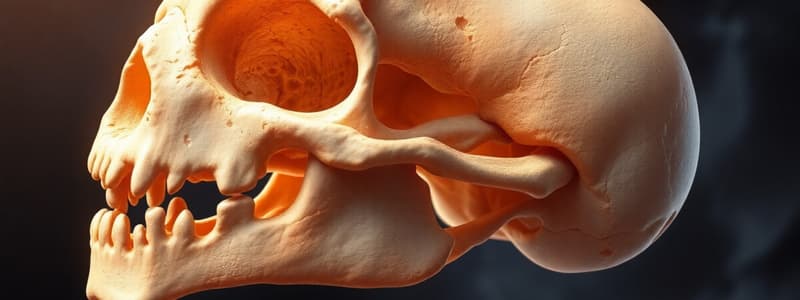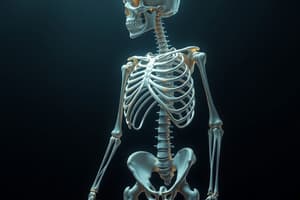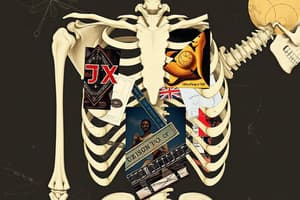Podcast
Questions and Answers
What is the primary characteristic of bone dysplasias?
What is the primary characteristic of bone dysplasias?
- Abnormal bone shape only
- Alteration in bone density
- Alteration in bone tissue formation (correct)
- Malalignment of bone structure
Which of the following is NOT a typical etiology for osteoporosis?
Which of the following is NOT a typical etiology for osteoporosis?
- Aging
- Physical inactivity (correct)
- Alcoholism
- Menopause
What is a common diagnostic tool for detecting osteoporosis?
What is a common diagnostic tool for detecting osteoporosis?
- CT scan
- MRI scan
- X-ray imaging
- Bone densitometry (correct)
Which treatment is commonly used to guide the growth of bones in cases of deformities?
Which treatment is commonly used to guide the growth of bones in cases of deformities?
Bone malformations can involve which of the following changes?
Bone malformations can involve which of the following changes?
What is the primary function of bone tissue?
What is the primary function of bone tissue?
Which type of bone is characterized by a dense and solid structure?
Which type of bone is characterized by a dense and solid structure?
What is the main component of the extracellular matrix in bone?
What is the main component of the extracellular matrix in bone?
Which statement about the biomechanical properties of bone is true?
Which statement about the biomechanical properties of bone is true?
What covers the external surfaces of bones?
What covers the external surfaces of bones?
Which type of bone contains a fine network-like structure?
Which type of bone contains a fine network-like structure?
What type of cells are involved in bone remodeling and are found in the periosteum?
What type of cells are involved in bone remodeling and are found in the periosteum?
Which structural component of long bones acts as the site for growth in children?
Which structural component of long bones acts as the site for growth in children?
What type of fracture occurs when the bone breaks but the skin remains intact?
What type of fracture occurs when the bone breaks but the skin remains intact?
Which type of joint allows for great movement?
Which type of joint allows for great movement?
Which type of bone has greater resistance to compression rather than traction?
Which type of bone has greater resistance to compression rather than traction?
What is the main disadvantage of compact bone in terms of biomechanical properties?
What is the main disadvantage of compact bone in terms of biomechanical properties?
Which of the following lamellae has greater resistance to shear forces?
Which of the following lamellae has greater resistance to shear forces?
What characterizes the Greenstick fracture?
What characterizes the Greenstick fracture?
What happens to collagen fibers under tensile stress?
What happens to collagen fibers under tensile stress?
What is the primary mineral component of bone known for its hardness and elasticity?
What is the primary mineral component of bone known for its hardness and elasticity?
What type of fracture occurs when the bone is crushed, becoming wider or flatter?
What type of fracture occurs when the bone is crushed, becoming wider or flatter?
Which etiology of fractures is characterized by a fracture due to repetitive motion?
Which etiology of fractures is characterized by a fracture due to repetitive motion?
What method of diagnosis primarily uses imaging to identify fractures?
What method of diagnosis primarily uses imaging to identify fractures?
In which type of fracture are there three or more pieces present at the fracture site?
In which type of fracture are there three or more pieces present at the fracture site?
Which symptom is NOT typically associated with a fracture?
Which symptom is NOT typically associated with a fracture?
What is a common conservative treatment for fractures?
What is a common conservative treatment for fractures?
Which of the following best describes an atypical bone deformity?
Which of the following best describes an atypical bone deformity?
What might be an indication for surgical treatment in fracture management?
What might be an indication for surgical treatment in fracture management?
What is a primary consequence of osteoporosis?
What is a primary consequence of osteoporosis?
Which of the following is a treatment option that directly addresses bone deformities?
Which of the following is a treatment option that directly addresses bone deformities?
What role do imaging tests play in diagnosing bone deformities?
What role do imaging tests play in diagnosing bone deformities?
Which condition is NOT a typical etiology for osteoporosis?
Which condition is NOT a typical etiology for osteoporosis?
Which symptom is commonly associated with osteoporosis?
Which symptom is commonly associated with osteoporosis?
What type of fracture is characterized by a straight-line break through the bone?
What type of fracture is characterized by a straight-line break through the bone?
Which of the following is not a symptom typically associated with fractures?
Which of the following is not a symptom typically associated with fractures?
What best describes a fracture caused by overuse or repetitive motion?
What best describes a fracture caused by overuse or repetitive motion?
Which diagnosis method utilizes imaging to identify fractures?
Which diagnosis method utilizes imaging to identify fractures?
What characterizes a segmental fracture?
What characterizes a segmental fracture?
Which type of fracture occurs when the bone is broken into three or more pieces?
Which type of fracture occurs when the bone is broken into three or more pieces?
What type of treatment is often required for extreme cases of bone deformities?
What type of treatment is often required for extreme cases of bone deformities?
What characteristic of compact bone contributes to its biomechanical weakness?
What characteristic of compact bone contributes to its biomechanical weakness?
How do individual trabeculae compare to osteons in terms of longitudinal modulus of elasticity?
How do individual trabeculae compare to osteons in terms of longitudinal modulus of elasticity?
What type of joint allows for a great range of movement?
What type of joint allows for a great range of movement?
Which type of fracture involves bone being exposed through the skin?
Which type of fracture involves bone being exposed through the skin?
What is the primary risk associated with fractures in terms of bone types?
What is the primary risk associated with fractures in terms of bone types?
What role do hydroxyapatite crystals play in the structure of bone?
What role do hydroxyapatite crystals play in the structure of bone?
In terms of lamellar resistance, which provides greater resistance to compression?
In terms of lamellar resistance, which provides greater resistance to compression?
What type of biomechanical tissue exhibits reorientation of trabeculae based on load?
What type of biomechanical tissue exhibits reorientation of trabeculae based on load?
Which statement accurately describes the composition of bone tissue?
Which statement accurately describes the composition of bone tissue?
How does the structure of cancellous bone differ from compact bone?
How does the structure of cancellous bone differ from compact bone?
Which biomechanical property of bone indicates its resistance to forces?
Which biomechanical property of bone indicates its resistance to forces?
What component primarily determines the elastic properties of bone?
What component primarily determines the elastic properties of bone?
What is the main characteristic of the diaphysis in long bones?
What is the main characteristic of the diaphysis in long bones?
What type of cells are primarily involved in the formation of bone?
What type of cells are primarily involved in the formation of bone?
Which aspect of bone's biomechanical behavior is true regarding flexural resistance?
Which aspect of bone's biomechanical behavior is true regarding flexural resistance?
Flashcards
Transverse Fracture
Transverse Fracture
A bone break that occurs in a straight line across the bone.
Spiral Fracture
Spiral Fracture
A bone break that occurs diagonally across the bone, often caused by twisting forces.
Compression Fracture
Compression Fracture
A bone break where the bone is crushed, becoming wider or flatter.
Comminuted Fracture
Comminuted Fracture
Signup and view all the flashcards
Segmental Fracture
Segmental Fracture
Signup and view all the flashcards
Traumatic Fracture
Traumatic Fracture
Signup and view all the flashcards
Stress Fracture
Stress Fracture
Signup and view all the flashcards
Disease Fracture
Disease Fracture
Signup and view all the flashcards
Modulus of Elasticity
Modulus of Elasticity
Signup and view all the flashcards
Tensile Strength
Tensile Strength
Signup and view all the flashcards
Compressive Strength
Compressive Strength
Signup and view all the flashcards
Torsional Strength
Torsional Strength
Signup and view all the flashcards
Shear Strength
Shear Strength
Signup and view all the flashcards
Closed Fracture
Closed Fracture
Signup and view all the flashcards
Open Fracture
Open Fracture
Signup and view all the flashcards
Bone Tissue
Bone Tissue
Signup and view all the flashcards
Compact Bone
Compact Bone
Signup and view all the flashcards
Cancellous Bone
Cancellous Bone
Signup and view all the flashcards
Epiphysis of a Long Bone
Epiphysis of a Long Bone
Signup and view all the flashcards
Diaphysis of a Long Bone
Diaphysis of a Long Bone
Signup and view all the flashcards
Periosteum
Periosteum
Signup and view all the flashcards
Endosteum
Endosteum
Signup and view all the flashcards
Biomechanical Properties of Bone
Biomechanical Properties of Bone
Signup and view all the flashcards
Bone dysplasia
Bone dysplasia
Signup and view all the flashcards
Bone misalignment
Bone misalignment
Signup and view all the flashcards
Bone malformation
Bone malformation
Signup and view all the flashcards
Osteoporosis
Osteoporosis
Signup and view all the flashcards
Bone densitometry
Bone densitometry
Signup and view all the flashcards
What is bone tissue?
What is bone tissue?
Signup and view all the flashcards
What is compact bone?
What is compact bone?
Signup and view all the flashcards
What is cancellous bone?
What is cancellous bone?
Signup and view all the flashcards
What is the epiphysis of a long bone?
What is the epiphysis of a long bone?
Signup and view all the flashcards
What is the diaphysis of a long bone?
What is the diaphysis of a long bone?
Signup and view all the flashcards
What is the periosteum?
What is the periosteum?
Signup and view all the flashcards
What is the endosteum?
What is the endosteum?
Signup and view all the flashcards
What are the biomechanical properties of bone?
What are the biomechanical properties of bone?
Signup and view all the flashcards
Diarthrodial Joint
Diarthrodial Joint
Signup and view all the flashcards
Synarthrodial Joint
Synarthrodial Joint
Signup and view all the flashcards
Conservative Treatment
Conservative Treatment
Signup and view all the flashcards
Surgical Treatment
Surgical Treatment
Signup and view all the flashcards
Study Notes
Bone Composition and Structure
- Bone tissue is a specialized connective tissue
- Its properties include hardness, high tensile and compressive resistance
- Main functions are body support, organ protection, calcium deposit and blood cell formation
- Bone structure comes in two forms
- Compact bone: dense and solid, without cavities
- Cancellous bone: fine, network-like trabeculae
- Long bones have:
- Epiphysis: cancellous bone with a thin compact bone layer
- Metaphysis: hyaline cartilage in children and epiphyseal line in adults
- Diaphysis: compact bone cylinder with an internal cavity
- Short bones are primarily cancellous bone with a thin compact bone layer
- Periosteum: covers external bone surfaces
- Dense connective tissue
- Contains osteoprogenitor cells, osteoblasts, and bone lining cells
- Endosteum: covers internal bone surfaces
- Includes osteoprogenitor cells
Bone Tissue Components
- Cells:
- Osteoprogenitor cells
- Osteoblasts
- Bone lining cells
- Osteocytes
- Osteoclasts
- Extracellular matrix:
- Mineralized bone matrix
- Contains hydroxyapatite crystals
- Fibers and ground substance
Biomechanical Properties of Bone
- Entire Structure:
- Greater resistance to compression than traction
- Weak against shear forces
- Flexural resistance depends on stiffness and fracture load
- Tissue Components:
- Compact bone: greater resistance to compression than traction; weak against torsion
- Cancellous bone: greater resistance to compression than traction; trabeculae are reoriented depending on load
- Molecular components:
- Collagen fibers show initial linear strain under tensile stress, then heterogeneous strain. Changes in mineral composition affect the strain pattern.
- Hydroxyapatite crystals have greater hardness/elasticity on basal surfaces, but greater resistance on laterals; greater tolerance to microfractures
Biomechanics of Osteons and Individual Trabeculae
- Longitudinal lamellae: resistant to traction and torsion
- Transverse lamellae: resistant to compression, shear, and flexion
- Individual trabeculae: lower longitudinal modulus of elasticity compared to cortical bone osteons
Biomechanics of Molecular Components
- Collagen fibers display initial linear then heterogeneous strain under tensile stress; mineral changes affect the strain pattern.
- Hydroxyapatite crystals show greater hardness/elasticity on basal faces, and higher resistance on laterals, and greater tolerance to microfractures.
Joint Classification
- Structure:
- Synarthrodial: immovable (sutures)
- Amphiarthrodial: slightly movable (pubic symphysis)
- Diarthrodial: freely movable (synovial joints)
- Types of diarthrodial joints (synovial):
- Ball and socket
- Hinge
- Pivot
- Condylar
- Saddle
- Plane
Surgical Effects
- Fractures: Total or partial breakage of bone; open fractures expose the bone, and closed fractures do not.
- Common fracture types: transverse, spiral, compression, comminuted, segmental, greenstick
- Fracture etiology: exceeding bone's force limit; traumatic (falls), overuse, or disease.
- Bone Deformities: Atypical structure deviations, congenital or acquired. Signs include pain, discomfort, and difficulty moving; often needing surgery or orthopedic devices.
Osteoporosis
- A disease characterized by decreased bone density/normal bone tissue
- Risk factors may include menopause, certain drugs, diseases, alcoholism.
- Symptoms often include "silent disease" (no pain until fracture, often of vertebrae, hip, or wrist).
- Diagnosis is via bone densitometry, and < -2.5 T-score indicates osteoporosis.
- Treatment may include dietary modifications for calcium intake, antiresorptives, bone-forming drugs, surgery (in some cases), and exercise.
- Exercise focus on endurance, strength and balance.
Bone Cancer
- Uncontrolled cell multiplication of abnormal bone cells
- Common types: osteosarcoma, chondrosarcoma, Ewing's sarcoma
- Symptoms often include severe pain and may lead to metastasis..
- Diagnosis frequently involves biopsy.
- Treatment may include surgery, chemotherapy, and radiation.
Stress Raisers
- Force divided by area subjected to force
- Common types: traction, compression, shear, torsion, bending/flexion; excessive force can lead to injury.
Hormone Stress
- Hormones influencing bone: Growth hormone, thyroid hormones, sex hormones (estrogen, progesterone, testosterone), insulin, IGFs, cortisol, parathyroid hormone, calcitonin
- Imbalance in these hormones can affect bone health.
Aging Effects on Bone
- Physiological processes, starting at conception, negatively affect bone mass and quality; increased fracture risks.
- Metabolic factors: decreased collagen quality; lower microfracture repair ability; increased bone resorption vs. formation. More bone breakdown than creation.
Histological Changes in Bone Tissue
- Relative loss of cancellous bone (compared to cortical bone), reduced number of trabeculae, increase in periosteum diameter to maintain mechanical integrity to fight microfractures, and decrease in angiogenesis, reduction in bone forming surfaces, decreasing of osteocalcin, shorter osteoblast cell half-life. and decreasing telomerase in somatic cells. These factors may impact proliferation and differentiation of blasts.
Oxidative Stress in Bone
- Imbalance in oxidizing/deoxidizing agents. Excessive ROS production damages cells, and inhibits action of osteogenic factors.
Additional Notes
- Specific points about the usefulness of certain interventions at different ages related to bone density/strength improvements are noted
- Bone remodeling, where bone is broken down and rebuilt, is a continuous process.
- Hormones, nutrition, and stress can influence the rate of bone remodeling.
- Bone quality and density decrease with age, and this can affect function.
Studying That Suits You
Use AI to generate personalized quizzes and flashcards to suit your learning preferences.




